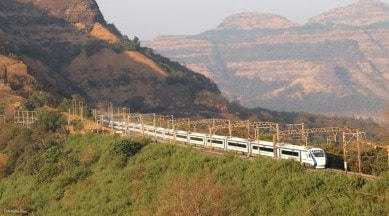Stay updated with the latest - Click here to follow us on Instagram
Advanced systems to help Vande Bharat trains cross steep ghats
No other Vande Bharat is equipped with the said advanced systems, said the official, adding that the two trains have the systems to enable them to cross the ghat section which is the steepest in gradient.

The two new Vande Bharat Express trains, to be introduced on CSMT-Shirdi and CSMT-Solapur routes, are equipped with “additional parking brakes” and “traction motor system” that will enable these trains to stop in case of signalling or emergency, and prevent it from rolling down on both routes comprising Ghat sections, said a senior Central Railway officer.
No other Vande Bharat is equipped with the said advanced systems, said the official, adding that the two trains have the systems to enable them to cross the ghat section which is the steepest in gradient. The officer further explained that express trains passing through the Ghat sections are attached with a banking engine that eliminates chances of uncoupling or the train rolling down the gradient. The additional engine assists in hauling a train up a steep gradient. With advanced systems, the Vande Bharat trains will not need the banking engine to pull the train, added the official.
There are two routes for Shirdi while the Vande Bharat will take route of CSTM-Shirdi via Manmad passing through Thal ghat. Also known as Thul ghat, it is the steepest ghat with ‘one in 37-degree gradient’ of the Indian Railways, meaning that it will have one metre of elevation every 37 metres. This 14-km ghat lies between Kasara and Igatpuri section.
While the CSMT-Solapur route Vande Bharat will pass through the 28-km Khandala Bhor ghat section. This ghat is also in the ‘one in 37-degree gradient’ category. For the Ghat section, the restricted speed limit of any express train is 55kmph. Therefore, to cross Thal ghat, Vande Bharat will take 20-25 minutes, and 40-45 minutes to cross Bhor ghat, the official explained.
The Vande Bharat, while ascending from CSMT to Solapur and Shirdi will not need the banking engine, which will save time and provide a non-stop journey unlike other express trains. In fact, Indian Railways have a dedicated crew to operate trains in Ghat section, while for Vande Bharat the specially trained ghat crew will not be needed for assistance.
The official said that equipment such as the parking brake and traction motor system in Vande Bharat cannot be used in other trains as they would need an advanced electrical system for it. Meanwhile, the PM will flag-off Vande Bharat trains from CSMT for Shirdi and Solapur on February 10 during his visit to Mumbai.
The Vande Bharat 2.0 version will run these two routes. The maximum speed limit of Vande Bharat train is 160-kmph, but depending on track fitness the train will runs at the respective speed limit, the official said. The two trains before flag off will be made ready so as to begin operation from February 10, as trial runs on both routes began from February 3rd and will continue for next two days.
A team from Research Design and Standards Organisation under Ministry of Indian Railways, the manufacturer of Vande Bharat train ICF (Indian Coach Factory) and other experts will supervise operations on these two routes. Based on their detailed report, a final approval for commercial operations will be given, said the official.